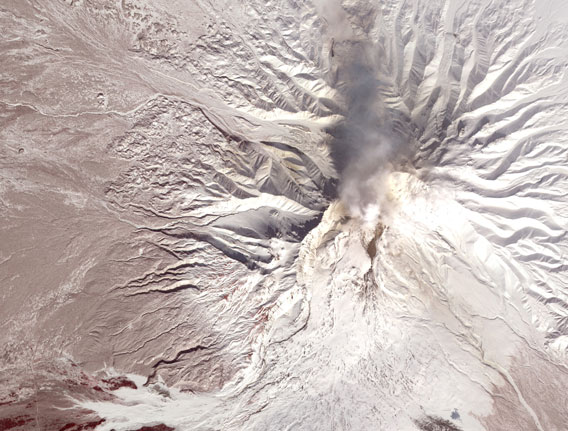Create a free profile to get unlimited access to exclusive videos, sweepstakes, and more!
Snowcano

Because pictures of volcanoes from space are never not cool, here is a shot looking straight down on Shiveluch, snowy and smoldering on Russia's Kamchatka Peninsula:
You really want to click that picture to see it in its full glory. You can clearly see the gullies carved by previous eruptions, sinuously snaking their way across the landscape. This is actually one small piece of a far larger and devastatingly gorgeous 8183x16626 pixel (23 Mb!) overview of the whole areaâfeaturing several other huge volcanoes such as Bezymianny, Tolbachik, Kizimen, and Klyuchevskaya, which are also erupting in the picture (click those to see incredible earlier space-based photos of them), as well as many smaller cones dotting the area.
This photo was taken on April 3, 2013, by the Terra Earth-observing satellite using ASTER, the Advanced Spaceborne Thermal Emission and Reflection Radiometer. This instrument sees visible light as well as in the infrared, including thermal infrared, emitted by hot objects (like, say, lava). Terraâs mission is to observe our planet and see how the climate is changing by examining how our different environments (land, water, ice, and air) interact with each other. It monitors air pollution in the form of aerosols and carbon monoxide, as well as a host of other services. Itâs a wonderful mission.
When it took this amazing shot of Shiveluch, the wind was relatively calm, only blowing gently north. You can see the plume from Shiveluch as it reaches skyward; the white in it is from steam, the reddish-brown from volcanic gases. For scale, the image above is about 25 kilometers (15 miles) across. This region is pretty difficult for geologists and volcanologists to reach, so satellite images like this provide critical near-real-time data on activity in the area. If you love this stuff like I do, then you can also see whatâs happening via the Kamchatka Volcanic Eruption Response Team site, which provides updates on eruptions and seismic activity in the area.
And I do love this stuff. Science is cool. In this case, you could even say it rocks.














